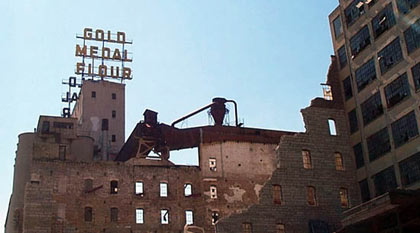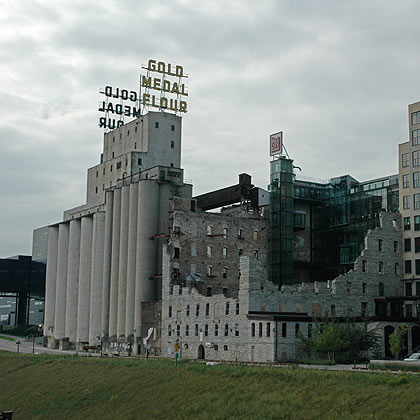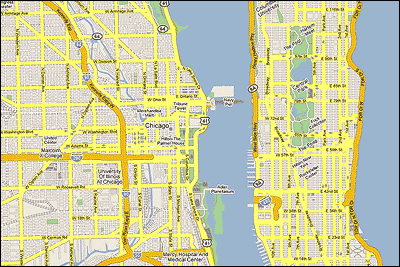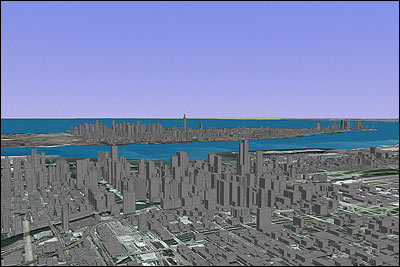kottke.org posts about Minneapolis
If you’ve ever been to downtown Minneapolis, you’ve likely used the large network of above-grade covered walkways that now stretches into nearly every corner of the downtown area. I’d always assumed they were built to help downtown workers and residents avoid cold weather during the winter, but that’s not the case.
Rather, the skyway system originally emerged from a twofold desire. First, planners in the 1940s and 50s were very concerned about managing increasingly dense pedestrian flows, and viewed skyways as a way to maximize the use of urban space for both people and automobiles (Byers 1998 154). Second, business owners were interested in maximizing their property values, and saw the skyways an opportunity to double the amount of valuable retail space in their downtown buildings (Byers 1998 159).
I used to work in downtown Minneapolis, and the skyways were great in the winter. To be able to take a walk and get lunch without having to bundle up in coat, hat, mittens, scarf, etc. was almost like living in a warm climate…and that’s no small thing during a long, dark Mpls winter. (via ★than)
In 1965, the Washburn A mill, the last operating flour mill in Minneapolis, became also the last flour mill to close its doors, having been preceded by an entire industry that, at one time, produced more flour than any other place in the U.S. The closure came when the mill’s operating company, General Mills, moved its headquarters to Golden Valley, where real estate was plentiful and inexpensive. The area around St. Anthony Falls, the geological feature responsible for the beginnings of industry in the area, had long since fallen into general disrepair and it wasn’t long before the Washburn A was deserted and inhabited by the homeless.
The area started to show signs of life again in the 70s and 80s after being added to the National Register of Historic Places in 1971. Old mill buildings were converted for non-industrial business and residential use as people began to recognize the unique character and history of the area around the falls. In 1991, the Washburn A building burned and part of its structure collapsed, but firefighters saved the rest of the historic building from destruction. The remnants of the building and the adjacent grain elevators remained empty for years afterwards, save for the occasional graffiti artist and urban spelunker.
I knew very little of this when I moved to the Twin Cities in 1996 and not much more when I left Minneapolis for San Francisco in 2000. Almost every weekday for two years I drove or pedaled past the shell of the Washburn A mill on the way to and from work on Washington Avenue in the warehouse district, where we manufactured web pages to fill a growing online space. Topped by the Gold Medal Flour sign, the mill became my favorite building in the Twin Cities, leading me to include it in The Minneapolis Sign Project I did for 0sil8 shortly before I left for the West Coast.

It seemed the perfect symbol of a time and industry long past, broken down but not entirely wiped away. I returned to visit Minneapolis occasionally and would drive past the Falls, wondering what would happen to my building, hoping against hope that they wouldn’t eventually tear it down. With the structure in such bad shape, demolition seemed to be the only option.
Last week, Meg and I spent a day in Minneapolis on our way to visit my parents in Wisconsin, my first stay in Mpls since mid-2002. Meg wanted to investigate running trails and I wanted to sneak a peek at the Gold Medal Flour Building (as I had taken to calling it), so we walked the three blocks to the river from our hotel, housed in the former Milwaukee Depot. The Gold Medal Flour sign was visible from several blocks away, so I knew they hadn’t torn down the grain elevators, but it wasn’t until I saw the shell of the Washburn A building peeking out around one of the other mill buildings that I knew it had been spared as well. As more of the building came into view, I saw a glass elevator rising from the ruins, backed by a glass facade.
What the??!?
Now practically running along the river in excitement and bewilderment, dragging poor Meg along with me in a preview of her jog the next morning, I saw a wooden boardwalk in front of the building and headed for what looked like the entrance. The burned out windows and broken glass remained; except for the elevator and the 8-story glass building sticking out the top, it looked much the same as it had after burning in 1991. I scrambled through the entrance and, lo, the Mill City Museum.

And what a museum. It was just closing when we got there, but we returned the next morning for a full tour of the museum and the Mill Ruins Park. The highlight of the museum is an elevator tour of the mill as it was back in the early 20th century. They load 30 people at a time into a giant freight elevator, which takes the group up to the 8th floor of the museum, stopping at floors along the way to view and hear scenes from the mills workings, narrated by former mill workers. After the elevator tour, you’re directed to an outdoor deck on the 9th floor, where you can view the shell of the mill building, St. Anthony Falls, the Stone Arch Bridge, the Gold Medal Flour sign, and the rest of the historic area.
Meyer, Scherer & Rockcastle are the architects responsible for the project, and they deserve all the accolades they get from one of the most unique museums I’ve ever been to. The statement from the American Institute of Architects jury explains the design of the museum:
A creative adaptive reuse of an extant shell of a mill building, with contrasting insertion of contemporary materials, weaving the old and the new into a seamless whole…A complex and intriguing social and regional story that reveals itself as the visitor progresses through the spaces. It is museum as a verb…A gutsy, crystalline, glowing courtyard for a reemerging waterfront district that attracts young and old and has stimulated adjacent development.
I still can’t quite believe they turned my favorite Minneapolis building (of all buildings) into a museum….and that it was done so well. More than anything, I’m happy and relieved that the Gold Medal Flour Building will always be there when I go back to visit. If you’re ever in Minneapolis, do yourself a favor and check it out.
Photos on Flickr tagged “mill city”
Photos on Flickr tagged “mill city museum”
Mill City: A Visual History of the Minneapolis Mill District was helpful in writing this post
A Washington Post review of the museum from September 2005
The new Guthrie Theater is right next door and is a dazzling building in its own right (photo, more photos)
A few months ago, I found a map online (which I cannot for the life of me relocate and I’m keen to find it again…any ideas? it’s from Bill Rankin’s The Errant Isle of Manhattan…see update below) of Manhattan pasted next to Chicago, as if the island had taken up permanent residence in Lake Michigan. Recently I decided to explore the unique aspect of Manhattan’s scale with a series of similar maps of places I’ve been to or lived in: Boston, Chicago, Minneapolis, San Francisco, and Barron, WI (my hometown). Manhattan Elsewhere is the result.
Depending on your vantage point, Manhattan seems either very big or very small. On complete map of the New York City area, Manhattan is dwarfed in size by the other four boroughs and surrounding megopolis. But for someone on the ground in Manhattan, the population density, the height of the buildings, the endless number of things to do, and the fact that many people don’t often leave their neighborhoods, much less the island, for weeks/months on end makes it seem a very large place indeed. This divergence sense of scales can cause quite a bit of cognitive dissonance for residents and visitors alike.


For the top image, I used the Google Maps representations of Manhattan and Chicago to create a composite map. In the bottom image, I used Google Earth’s 3-D views to create a approximate view of Manhattan from Chicago. In all cases, Manhattan is to scale with the other cities. Click through for larger images and other cities.
Update: The map on which Manhattan Elsewhere is based was done by Bill Rankin, who runs the excellent Radical Cartography site, and is part of The Errant Isle of Manhattan project. He also did maps for Boston, SF, Door County, WI, Philly, and Los Angeles (look at how gigantic LA is!), which I completely forgot about. He also made more of an effort than I did to connect the roads. (thx, zach)
One of my favorite things to do in new cities is to observe how the traffic works. Traffic in each place has a different feel to it that depends on the culture, physical space, population density, legal situation, and modes of transportation available (and unavailable).
Everyone drives in LA and Minneapolis, even if you’re only going a few blocks. In San francisco, pedestrians rule the streets…if a pedestrian steps out into the crosswalk, traffic immediately stops and will stay stopped as long as people are crossing, even if that means the cars are going nowhere, which is great if you’re walking and maddening if you’re driving. In many cities, both in the US and Europe, people will not cross in a crosswalk against the light and will never jaywalk. In many European cities, city streets are narrow and filled with pedestrians, slowing car traffic[1]. US cities are starting to build bike lanes on their streets, following the example of some European cities.
In NYC, cars and pedestrians take turns, depending on who has the right-of-way and the opportunity, with the latter often trumping the former. Cabs comprise much of the traffic and lanes are often a suggestion rather than a rule, more than in other US cities. With few designated bike lanes, cycling can be dangerous in the fast, heavy traffic of Manhattan. So too can cyclers be dangerous; bike messengers will speed right through busy crosswalks with nothing but a whistle to warn you.
In Bangkok, traffic is aggressive, hostile even. If a driver needs a space, he just moves over, no matter if another car is there or not. Being a pedestrian is a dangerous proposition here; traffic will often not stop if you step out into a crosswalk and it’s impossible to cross in some places without the aid of a stoplight or overpass (both of which are rare). More than any other place I’ve been, I didn’t like how the traffic worked in Bangkok, either on foot or in a car.
Traffic in Saigon reminds me a bit of that in Beijing when I visited there in 1996. Lots of communication goes on in traffic here and it makes it flow fairly well. Cars honk to let people know they’re coming over, to warn people they shouldn’t pull in, motorbikes honk when they need to cross traffic, and cars & motorbikes honk at pedestrians when it’s unsafe for them to cross. Traffic moves slow to accommodate cars, the legions of motorbikes (the primary mode of transportation here), and pedestrians all at the same time.[2] Crossing the street involves stepping out, walking slowly, and letting the traffic flow around you. Drivers merging into traffic often don’t even look before pulling out; they know the traffic will flow around them. The system requires a lot of trust, but the slow speed and amount of communication make it manageable.[3]
[1] This is the principle behind traffic calming.
[2] That traffic calming business again.
[3] Not that it’s not scary as hell too. American pedestrians are taught to fear cars (don’t play in the street, look both ways before crossing the street, watch out for drunk drivers) and trusting them to avoid you while you’re basically the frog in Frogger…well, it takes a little getting used to.
Although the sandwich was named so after an 18th century British Earl, its invention dates back to a rabbi who lived in the first century B.C.. In my short history, I’ve eaten more than my fair share of sandwiches and while I can’t consider myself a true connoisseur, the humble sandwich is one of my favorite things to eat and the ultimate in comfort foods.
The keys to a good sandwich are the three Bs: bread, balance, and…ok, there’s only two Bs, but they’re important. Aside from the main ingredient (turkey, tuna, chicken salad, etc.), the bread has the power to make or break a sandwich. The first thing you taste when you take a bite is the bread, so it had better be good and it had better be fresh.
Balance, or how the various parts come together to make a whole sandwich experience, is even more critical than the bread. Too much meat and the sandwich tastes only of meat. (The “famous” delis in NYC are big offenders here…the amount of meat in their sandwiches is way too much. These are sandwiches for showing off, not consumption.) Too much mustard and you overwhelm that beautiful pastrami. The mighty sandwich should not be a lowly conduit for your mustard addiction; why not just eat it straight from the jar? If you’ve got a dry bread, add a slice of tomato, a little extra mayo, or save it for tuna or egg salad. If you’ve got a lot of bread (a Kaiser or sub roll, for example), you’ll probably need more of everything else to balance it out. Make sure the ingredients are distributed evenly throughout the sandwich. You should get a bit of everything in each bite…it’s a BLT, not just an L on toast. If the sandwich maker is doing his job right, you should be able to taste most of the ingredients separately and together at the same time.
Here are a few sandwiches I’ve enjoyed over the years. I haven’t included any of the ones that I regularly make for myself because they’re pretty boring, although IMO, they’re right up there with any of these.
In college, when my friends and I got sick of eating on campus (and had the money to do so), we’d venture across the street to Zio Johno’s, a little Italian place with good, cheap food. At first I just got the spaghetti or lasagna, but one time I tried the Italian sub they offered and I was hooked. The key was the super-sweet sub roll; my measely $3 was enough for both a savory dinner and sweet dessert at the same time. I’ve never found anywhere else that uses bread that sweet.
I’ve lived in NYC for three years now, but I haven’t run across a steak sandwich that rivals the one I used to get on my lunch break at The Brothers’ Deli in Minneapolis. Fried steak, fried onions, and cheddar cheese on a Kaiser roll with a side order of the best potato salad I’ve ever had[1].
Surdyk’s (say “Sir Dicks”) is an institution in Northeast Minneapolis (say “Nordeast”), the finest liquor store and cheese shop around. They also had good croissants (say “Qua Sawn” or “Cross Aunts”) on which they put fresh ham, Swiss cheese, lettuce, tomato, and mayonnaise. Mmm.
There’s nothing I like more than a good BLT, and Specialty’s in San Francisco has one of the best I’ve had. Secret ingredient: pickles. Also, they didn’t toast the bread, which I usually frown upon, but it worked well anyway.
As for New York, I don’t live close to any good delis, but when I worked in Midtown, I used to zip over to the food court below Grand Central and hit Mendy’s. Their chicken salad is top-notch; the chicken is good quality and it isn’t overwhelmed by the mayonnaise. I’m usually not such a fan of rye bread, but their rye (it’s a light rye) is fantastic and goes very well with the chicken salad. The salami is good too. I usually have half a sandwich with a cup of their chicken noodle.
Do you have a favorite sandwich? Know of any good NYC sandwich spots I should check out?
[1] Although Meg has been making this warm garlic potato salad lately that is a serious contender for the top spot.









Stay Connected